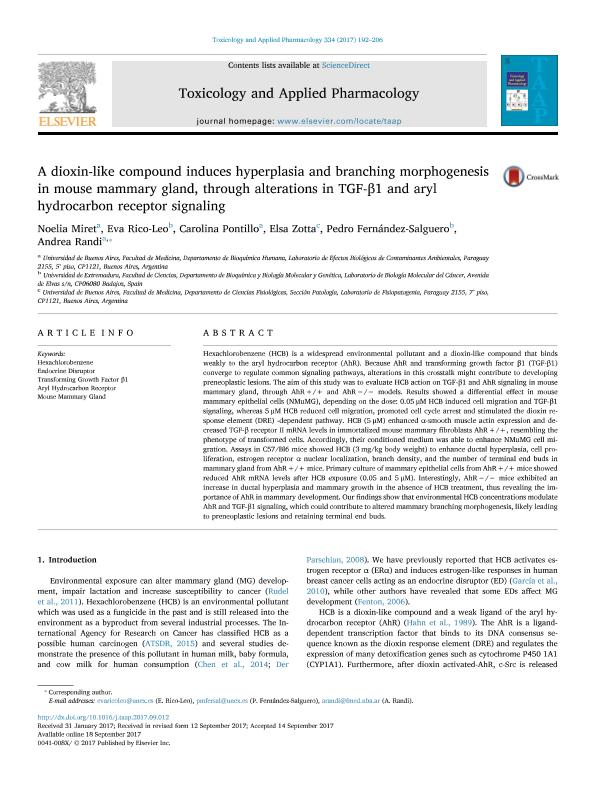Mostrar el registro sencillo del ítem
dc.contributor.author
Miret, Noelia Victoria

dc.contributor.author
Rico Leo, Eva
dc.contributor.author
Pontillo, Carolina Andrea

dc.contributor.author
Zotta, Elsa

dc.contributor.author
Fernández Salguero, Pedro
dc.contributor.author
Randi, Andrea Silvana

dc.date.available
2018-06-14T14:48:59Z
dc.date.issued
2017-11
dc.identifier.citation
Miret, Noelia Victoria; Rico Leo, Eva; Pontillo, Carolina Andrea; Zotta, Elsa; Fernández Salguero, Pedro; et al.; A dioxin-like compound induces hyperplasia and branching morphogenesis in mouse mammary gland, through alterations in TGF-β1 and aryl hydrocarbon receptor signaling; Academic Press Inc Elsevier Science; Toxicology and Applied Pharmacology; 334; 11-2017; 192-206
dc.identifier.issn
0041-008X
dc.identifier.uri
http://hdl.handle.net/11336/48626
dc.description.abstract
Hexachlorobenzene (HCB) is a widespread environmental pollutant and a dioxin-like compound that binds weakly to the aryl hydrocarbon receptor (AhR). Because AhR and transforming growth factor β1 (TGF-β1) converge to regulate common signaling pathways, alterations in this crosstalk might contribute to developing preneoplastic lesions. The aim of this study was to evaluate HCB action on TGF-β1 and AhR signaling in mouse mammary gland, through AhR +/+ and AhR −/− models. Results showed a differential effect in mouse mammary epithelial cells (NMuMG), depending on the dose: 0.05 μM HCB induced cell migration and TGF-β1 signaling, whereas 5 μM HCB reduced cell migration, promoted cell cycle arrest and stimulated the dioxin response element (DRE) -dependent pathway. HCB (5 μM) enhanced α-smooth muscle actin expression and decreased TGF-β receptor II mRNA levels in immortalized mouse mammary fibroblasts AhR +/+, resembling the phenotype of transformed cells. Accordingly, their conditioned medium was able to enhance NMuMG cell migration. Assays in C57/Bl6 mice showed HCB (3 mg/kg body weight) to enhance ductal hyperplasia, cell proliferation, estrogen receptor α nuclear localization, branch density, and the number of terminal end buds in mammary gland from AhR +/+ mice. Primary culture of mammary epithelial cells from AhR +/+ mice showed reduced AhR mRNA levels after HCB exposure (0.05 and 5 μM). Interestingly, AhR −/− mice exhibited an increase in ductal hyperplasia and mammary growth in the absence of HCB treatment, thus revealing the importance of AhR in mammary development. Our findings show that environmental HCB concentrations modulate AhR and TGF-β1 signaling, which could contribute to altered mammary branching morphogenesis, likely leading to preneoplastic lesions and retaining terminal end buds.
dc.format
application/pdf
dc.language.iso
eng
dc.publisher
Academic Press Inc Elsevier Science

dc.rights
info:eu-repo/semantics/openAccess
dc.rights.uri
https://creativecommons.org/licenses/by-nc-sa/2.5/ar/
dc.subject
Aryl Hydrocarbon Receptor
dc.subject
Endocrine Disruptor
dc.subject
Hexachlorobenzene
dc.subject
Mouse Mammary Gland
dc.subject
Transforming Growth Factor Β1
dc.subject.classification
Otras Ciencias de la Salud

dc.subject.classification
Ciencias de la Salud

dc.subject.classification
CIENCIAS MÉDICAS Y DE LA SALUD

dc.title
A dioxin-like compound induces hyperplasia and branching morphogenesis in mouse mammary gland, through alterations in TGF-β1 and aryl hydrocarbon receptor signaling
dc.type
info:eu-repo/semantics/article
dc.type
info:ar-repo/semantics/artículo
dc.type
info:eu-repo/semantics/publishedVersion
dc.date.updated
2018-06-13T15:07:24Z
dc.journal.volume
334
dc.journal.pagination
192-206
dc.journal.pais
Estados Unidos

dc.journal.ciudad
Nueva York
dc.description.fil
Fil: Miret, Noelia Victoria. Consejo Nacional de Investigaciones Científicas y Técnicas; Argentina. Universidad de Buenos Aires. Facultad de Medicina. Departamento de Bioquímica Humana; Argentina
dc.description.fil
Fil: Rico Leo, Eva. Universidad de Extremadura; España
dc.description.fil
Fil: Pontillo, Carolina Andrea. Consejo Nacional de Investigaciones Científicas y Técnicas; Argentina. Universidad de Buenos Aires. Facultad de Medicina. Departamento de Bioquímica Humana; Argentina
dc.description.fil
Fil: Zotta, Elsa. Universidad de Buenos Aires. Facultad de Medicina. Departamento de Ciencias Fisiológicas; Argentina
dc.description.fil
Fil: Fernández Salguero, Pedro. Universidad de Extremadura; España
dc.description.fil
Fil: Randi, Andrea Silvana. Consejo Nacional de Investigaciones Científicas y Técnicas; Argentina. Universidad de Buenos Aires. Facultad de Medicina. Departamento de Bioquímica Humana; Argentina
dc.journal.title
Toxicology and Applied Pharmacology

dc.relation.alternativeid
info:eu-repo/semantics/altIdentifier/doi/https://dx.doi.org/10.1016/j.taap.2017.09.012
dc.relation.alternativeid
info:eu-repo/semantics/altIdentifier/url/https://www.sciencedirect.com/science/article/pii/S0041008X17303848
Archivos asociados
